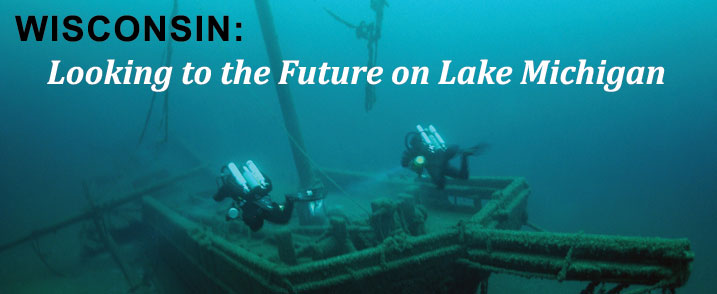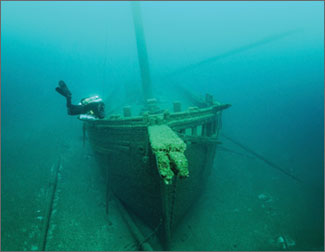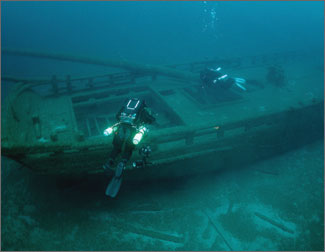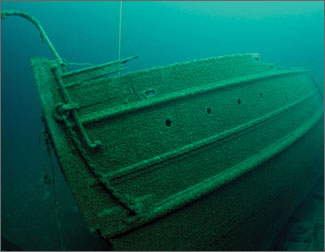

The waters of Lake Michigan are home to well-preserved shipwrecks spanning more than 125 years of maritime travel and commerce on the Great Lakes. Groups like the Wisconsin Maritime Museum and Wisconsin Historical Society are working to secure greater long-term protection for these historical treasures.



Home to some of the best preserved and historically significant shipwrecks in the United States, Thunder Bay National Marine Sanctuary is a world-class wreck diving destination, on par with places such as Scapa Flow in Scotland and Truk Lagoon in Micronesia.

Click here to check out Thunder Bay's wrecks.
Norma Bishop grew up outside Chicago, but it’s the time she spent with her family on Lake Michigan that would leave the deepest impression on her life. “So many of my early experiences were on the water that I felt the lake was a part of me,” she says. “If I got homesick, I got homesick for the lake.” Her love of the water led to a career in the U.S. Navy, during which she served as an air traffic controller in far-flung locations across the Pacific like the tropical atoll of Diego Garcia.
She retired from active duty after 21 years of service and practiced law in San Francisco for several years before accepting a position as executive director of the Santa Barbara Maritime Museum in 2003. In 2005, Bishop heard that the Wisconsin Maritime Museum, located in Manitowoc along the shores of Lake Michigan, was searching for a new CEO. News of the job opening brought memories from her childhood flooding back. “I never expected to come back here,” she says. “It was fate, I guess.”
A Wisconsin Sanctuary?
 It’s one of the best collections of
19th-century wrecks in the world. It’s one of the best collections of
19th-century wrecks in the world.- Keith Meverden |
Fate or otherwise, Bishop got the job. For the first time in more than 25 years, she returned to the lake she grew up on and quickly fell back in love with it. Working at the museum gave her a greater appreciation of the lake’s history — and the countless shipwrecks hidden beneath its surface like time capsules of centuries past. “It’s one of the best collections of 19th-century wrecks in the world,” says Keith Meverden, Wisconsin state underwater archaeologist. Around the time that Bishop arrived in Manitowoc, Meverden and colleague Tamara Thomsen were working on an inventory of those shipwrecks for the Wisconsin Historical Society. Their report evaluated Wisconsin’s collection of historic shipwrecks for the possibility of NOAA designating a national marine sanctuary in Wisconsin’s Great Lakes waters. The recommended study area included the Lake Michigan waters off of Two Rivers, Manitowoc, Cheboygan and Port Washington.
When Bishop learned in 2006 about the interest in a national marine sanctuary, she was enthralled with the idea. She visited Alpena, a small Michigan city on Lake Huron, where she saw the positive impact Thunder Bay National Marine Sanctuary had had on the local community in the six years since its designation. Residents spoke about the sanctuary’s revitalizing effect on tourism and how its education programs helped them connect with their shared history. She wanted that for Wisconsin. “I thought oh, wow, this is incredible! We could make this happen,” she says.
Laying the Groundwork
As plans for evaluating a possible national marine sanctuary in Wisconsin
took shape, Bishop began working to rally support — first in the
local schools, chamber of commerce, city council and mayor’s office, then
in the governor’s office and state legislature. She talked to anyone who
would listen about the incredible historical shipwrecks in Lake Michigan,
and the importance of protecting them and sharing them with the world.
“The first challenge was just explaining to people that this is not going to
be another regulatory burden on their lives,” she says.
Bishop didn’t face the challenges alone. In addition to her work through the maritime museum, others like Meverden and Thomsen at the Wisconsin Historical Society played vital roles in building a groundswell of support for the sanctuary proposal. “I think we provide a really good complement to one another,” Meverden says. But as everyone involved would come to learn, sometimes even dedicated teamwork, widespread support and positive momentum are no guarantee of immediate, or even moderately swift, success.
No Sanctuary in Sight?
Six years have passed since the effort to consider designating a sanctuary
in Lake Michigan began, with little progress to show for it. Bishop remains
optimistic, but admits that the lack of progress has been frustrating. “Never
in my wildest imagination did I think it would take this long,” she says.
One of the hurdles facing the Wisconsin effort — or any new sanctuary designation effort — can be found in NOAA's regulations for sanctuaries. Those regulations require that in order for any site to be actively considered for sanctuary status, it must come from a list of candidate sites, called the “Site Evaluation List.” NOAA’s regulations also state that this list of potential sanctuary candidate sites is inactive and would need to be reactivated if Wisconsin is to begin the designation process in earnest.
As a result, Bishop and her colleagues have spent much of the past half-dozen years in a holding pattern, hoping for a signal from NOAA or Congress that they can move forward. “We’ve felt like the girl sitting on the other side of the gym, waiting to be asked to dance,” she says.
They aren’t alone. Communities around the nation have expressed interest in marine sanctuaries in places like the waters off St. Augustine in northeast Florida, Mallow’s Bay in Maryland, Santa Lucia Bank off California’s central coast, and many others. Their efforts vary widely in size, scope and level of support, but the end goal is the same: to ensure the future of the ocean places that matter to them.
In for the Long Haul
The politics are complicated, and Bishop says she knows it could easily
take another six years or more to reach their goal, but she continues
to see signs of encouragement. As recently as August, the Manitowoc
City Council voted unanimously in favor of a resolution supporting the
creation of a national marine sanctuary off their shores.
When asked if she would ever contemplate giving up on the idea of a sanctuary for Wisconsin, Bishop responded with the conviction shared by countless others who have fought to protect special places for future generations throughout the 40-year history of the National Marine Sanctuary System.
“No. Never. The shipwrecks are going to be here for a long, long time, so I’m committed.”
